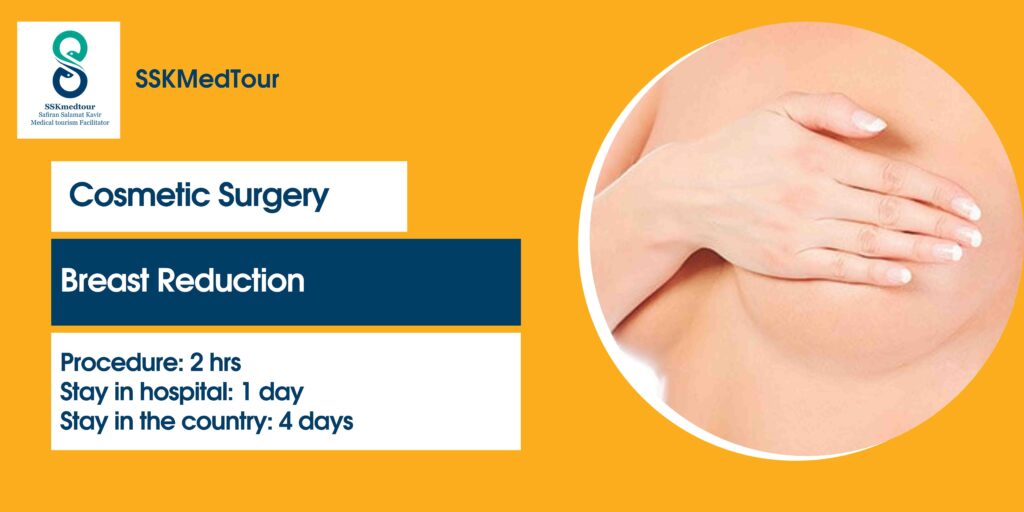
Excessively large breasts often result in both functional and psychological problems for the patient. Functional issues could involve the following: neck and upper back pain, pain in the shoulders due to grooving by the bra straps, and skin problems such as infections or eczema due to constant friction and rubbing in the folds. Patients may also experience problems finding bras or clothes, and social embarrassment.
Why it’s done
Breast reduction surgery is meant for people who have large breasts that cause the following:
- Chronic back, neck and shoulder pain
- Shoulder grooves from bra straps
- Chronic rash or skin irritation under the breasts
- Nerve pain
- Not being able to take part in some activities
- Poor self-image due to large breasts
- Trouble fitting into bras and clothing
Breast reduction surgery generally isn’t recommended for people who:
- Smoke
- Are very obese
- Don’t want scars on the breasts
You can have breast reduction surgery at any age — sometimes even as a teenager. But breasts that aren’t yet fully grown might need a second surgery later in life.
Reasons to postpone breast reduction surgery include:
- Planning to have children. Breastfeeding might be challenging after breast reduction surgery. However, certain surgical techniques can help keep the ability to breastfeed.
- Planning to lose weight. Losing weight can often result in changes to breast size.
Risks
Breast reduction surgery has the same risks as other major surgeries — bleeding, infection and a bad reaction to the anesthesia. Other possible risks include:
- Bruising, which is temporary
- Scarring
- Difficulty or inability to breastfeed
- Differences in the size, shape, and look of the left and right breasts
- Not being happy with the results
- Rarely, losing the nipples and skin around the nipples or the feeling in them
How you prepare
Your plastic surgeon will likely:
- Look at your medical history and overall health
- Discuss what size you want your breasts to be and how you want them to look after the surgery
- Describe the surgery and its risks and benefits, including likely scarring and possible loss of feeling
- Examine and measure your breasts
- Take photographs of your breasts for your medical record
- Explain the type of medicine used to put you to sleep during surgery
Planning breast reduction surgery might require:
- A mammogram
- Not smoking for at least six weeks before and after surgery
- Not taking aspirin, anti-inflammatory drugs and herbal supplements, to control bleeding during surgery
Usually, you can go home the day of the surgery. Arrange for someone to drive you home from the hospital.
What you can expect
Breast reduction surgery is usually done under general anesthesia, either in a hospital or outpatient surgical center.
During the procedure
The method used to reduce the size of your breasts can vary. The process might include:
- Surgery through incisions
- Liposuction to remove excess fat in the breasts
The surgeon usually:
- Makes an incision around the nipple and areola and down each breast
- Removes excess breast tissue, fat and skin to reduce the size of each breast
- Reshapes the breast and resets the nipple and area around it, also known as the areola
The nipple and the area around it usually stay attached to the breast. For very large breasts, the surgeon might need to remove them and add on a new nipple.
Your surgeon will try to make your breasts look alike, but breast size and shape might vary somewhat. The size of the areola also might be smaller. The incision scars will fade over time, but they won’t completely go away.
After the procedure
Immediately after surgery:
- The breasts are covered with bandages and a surgical bra to hold them in place
- A tube might be placed under each arm to drain any extra blood or fluid
- You may receive medicine for pain and medicine to decrease the risk of infection
For the first days or week after surgery:
- The breasts will probably feel tender
- The breasts might be swollen and bruised
- A surgical bra that closes in front is worn to support the breasts
After that:
- Limit physical activity for 4 to 6 weeks while the breasts heal
- Wear an approved surgical bra at all times to allow the breasts to heal and reduce swelling
Scarring fades over time. You will need a follow-up visit with your surgeon to check your recovery.
this essay is taken from: https://www.mayoclinic.org/tests-procedures/breast-reduction-surgery/about/pac-20385246


No comment